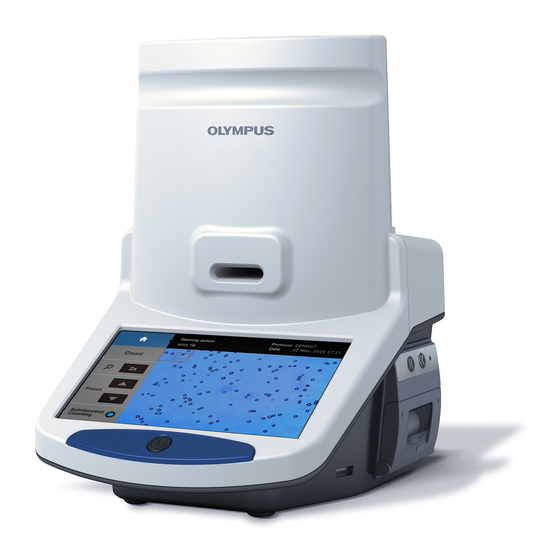Olympus R1 Instructions Manual - Page 24
Browse online or download pdf Instructions Manual for Laboratory Equipment Olympus R1. Olympus R1 47 pages. Cell counter
Also for Olympus R1: Quick Reference Manual (2 pages)

Chapter 3 – Protocol Settings
The R1 provides a default protocol that can be used for most common cell lines. Users may create and save up
to 300 unique protocols.
3.1 Protocol Parameters
The R1 protocols have the following modifiable parameters:
Parameter
Dilution Factor
Noise Reduction
Live Cell Sensitivity
Roundness (%)
Min. Cell Size (µm)
Max. Cell Size (µm)
Declustering Level
Dilution Factor: The dilution factor is used to calculate cell concentrations accurately. The default dilution
factor is preset as 1 for the Staining option: Without Trypan Blue and 2 for With Trypan Blue, assuming a 1:1
ratio of trypan blue to cell suspension. Users can modify this value according to the dilution of the original
sample in increments of 1 between 2 to 10 and of 10 between 10 to 100. For users handling high density cells
(e.g. fermented CHO cells), serial dilutions and several counts with appropriately adjusted dilution factors will
be necessary.
Noise Reduction: This option allows for the adjustment of background noise during counting. With more noise
reduction, the instrument will be less sensitive and not detect weakly stained cells. With lower noise reduction,
the instrument can detect objects with faint signals. Adjusting this parameter will help optimize for different cell
types as trypan blue staining can vary from cell to cell.
Live Cell Sensitivity: Live cells with intact cell membranes exclude trypan blue. Trypan blue forms annular
shade around live cells and stain the cytoplasm of dead cells or cells with compromised membranes. With a
higher live cell sensitivity, the instrument can detect smaller cells by registering smaller annular shade. For
most cells, this option should be set to 1. For peripheral blood mononuclear cells (PBMCs) or smaller, set it to ≥
5.
Roundness: As not all cells are completely spherical, adjusting the roundness allows for the detection of a
variety of cells. Higher percentages lead to the counting of rounder cells and excludes objects with less
roundness. Lower percentages are suitable for counting cells with irregular shapes.
Minimum and Maximum Cell Size: Cell sizes also vary. Users can customize cell size parameters to detect
specific cells efficiently. Values can be adjusted in 1 µm increments for sizes between 3-60 µm.
Declustering Level: The declustering function allows for the efficient detection of a variety of cells that may
clump or grow in clusters. Higher levels of declustering will increase counting time. This function is helpful for
counting sticky cells or rod-shaped spores.
Range
1 - 100
1 - 10
1 - 9
0 - 100
3 - 59
4 - 60
None, Low, Medium, High
23
DEFAULT
2
5
1
60
3
60
Medium
